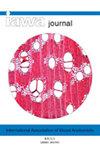采用DART-TOFMS、显微解剖和荧光光谱法对翼果木进行独立和互补分析
IF 3.5
3区 农林科学
Q2 FORESTRY
引用次数: 11
摘要
对非法采伐行为的关注和跨国木材贸易中苛刻的政策推动了对木材进行物种一级鉴定的需要。历史上,木材已经通过显微镜和解剖学特征鉴定到属水平,然而,新的化学计量学和成像方法已经开发出来,以提高木材鉴定的速度和精度。本研究利用互补的方法组合进行物种鉴定:实时飞行时间质谱直接分析(DART-TOFMS)、木材解剖和荧光光谱。研究了7种具有重要商业价值和环境价值的狐猴属物种,包括狐猴属(附录II)、桑塔林属(附录II)、红狐猴属(附录II)、indicus、大狐猴属、dalbergioides和大豆狐猴属。结果表明,DART-TOFMS结合主成分判别分析(discriminant analysis of principal components, PCA)对物种的分类准确率为95 ~ 100%,而解剖学结合主成分判别分析(PCA)结合荧光光谱对CITES附录II物种进行分类的准确率为95 ~ 100%。在没有DART-TOFMS的情况下,木材解剖和荧光光谱法的结合可以比单独解剖更准确地进行鉴定。本文章由计算机程序翻译,如有差异,请以英文原文为准。
Pterocarpus wood identification by independent and complementary analysis of DART-TOFMS, microscopic anatomy, and fluorescence spectrometry
Attention to illegal logging practices and demanding policies in transnational timber trade have driven the need for species-level identification of timber. Historically wood has been identified to genus level using microscopy and anatomical characteristics, however, new chemometric and imaging methods have been developed to increase the speed and precision of timber identification. This study approaches species identification using a combination of complementary methods: Direct Analysis in Real Time–Time-of-Flight Mass Spectrometry (DART-TOFMS), wood anatomy, and fluorescence spectroscopy. Seven commercially and environmentally significant species in Pterocarpus, including P. erinaceus (CITES Appendix II), P. santalinus (CITES Appendix II), P. tinctorius (CITES Appendix II), P. indicus, P. macrocarpus, P. dalbergioides, and P. soyauxii were studied. It was found that DART-TOFMS paired with discriminant analysis of principal components (PCA) could classify species with an accuracy of 95–100%, while anatomy in combination with PCA applied to fluorescence spectra could be used to classify CITES Appendix II species. In the absence of access to DART-TOFMS, a combination of wood anatomy and fluorescence spectrometry can permit more accurate identification than anatomy alone.
求助全文
通过发布文献求助,成功后即可免费获取论文全文。
去求助
来源期刊

IAWA Journal
农林科学-林学
CiteScore
3.40
自引率
15.80%
发文量
26
审稿时长
>36 weeks
期刊介绍:
The IAWA Journal is the only international periodical fully devoted to structure, function, identification and utilisation of wood and bark in trees, shrubs, lianas, palms, bamboo and herbs. Many papers are of a multidisciplinary nature, linking
 求助内容:
求助内容: 应助结果提醒方式:
应助结果提醒方式:


